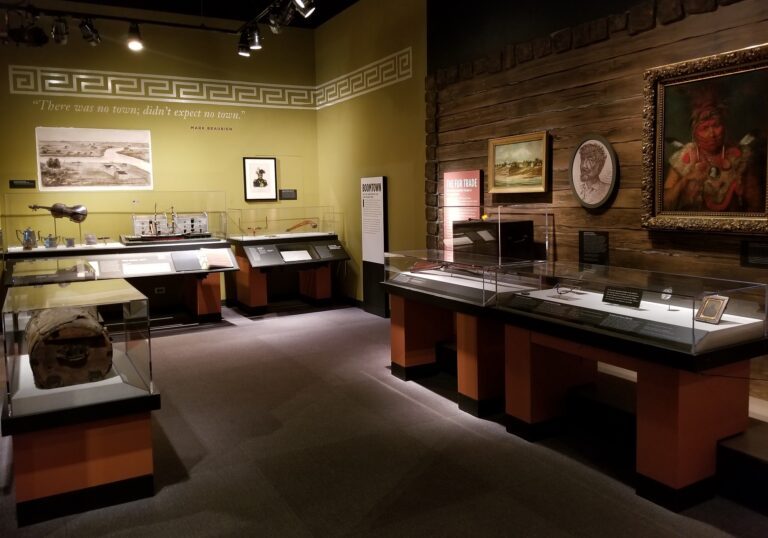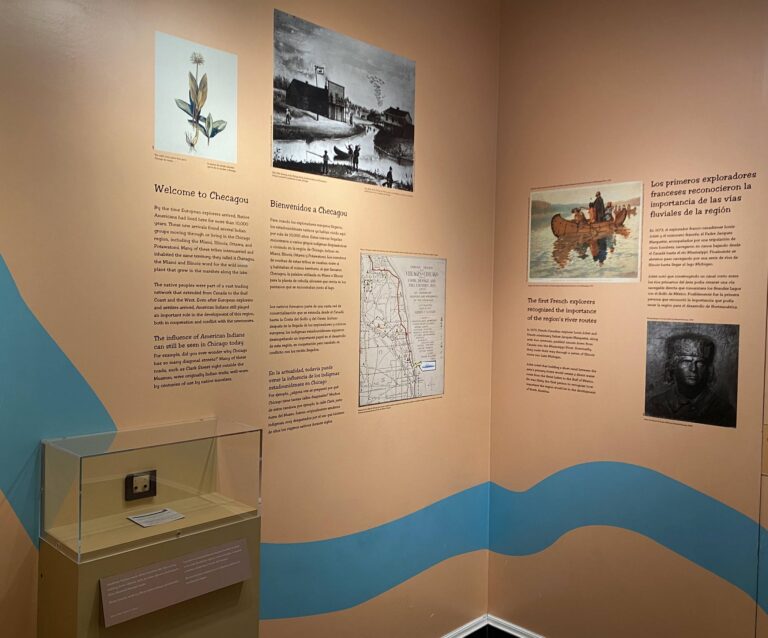In this blog post, CHM registrar Jamie Lewis writes about the Native American Graves Protection and Repatriation Act (NAGPRA) and how the Chicago History Museum is working to improve the stewardship of its Native American holdings.

The gallery in Chicago: Crossroads of Chicago that discusses the region’s Indigenous tribes and European colonization. All photographs by Jamie Lewis.
Over the past year, the Chicago History Museum (CHM) has been making a few changes in how we display and handle Native American cultural items. Along with other museums in the United States, including the Field Museum and American Museum of Natural History, we are ensuring continued Native American Graves Protection and Repatriation Act (NAGPRA) compliance following recent legislative changes and making a concerted effort to enhance practices regarding the care and interpretation of collections and acknowledging Native tribes as experts of their own histories.
What has CHM removed from display and why?
CHM has removed several items from display in the exhibition Chicago: Crossroads of America on the Museum’s second floor as well as from the small alcove in Imagining Chicago: The Dioramas on the first floor. These cultural items are either known or likely to have been taken from Native American burials. We consider these types of items to be “culturally sensitive,” meaning that there is a cultural reason for us not to display them, and there may be special, culturally specific guidelines for caring for them. While some non-Native people may feel that displaying funerary items is acceptable, CHM believes most Native American communities do not want these types of items on public view. And in fact, some believe that museums should not really have them at all. NAGPRA, passed in 1990, is one legislative measure that was created to ensure the protection of Native burials and to facilitate the return of human remains (or ancestors) and funerary objects, as well as other important cultural items.

The Native American section of Imagining Chicago: The Dioramas.
What is the purpose of NAGPRA?
The looting of Native American burials and sacred sites has been part of the United States’ history from earliest European contact and continues to this day (1). Laws exist all over the country criminalizing the vandalization of cemeteries and graves but have historically failed to protect those of Native people (2). The passage of NAGPRA is only one chapter in a long history of a struggle for equal protection under the law. For over thirty years, museums and federal agencies have been confronted with reevaluating business as usual, resulting in a lot of positive changes for the rights of Native people, and in some cases improving relationships between museums and tribes.
Why are these changes happening now?
Among other significant changes, new NAGPRA regulations prohibit the display of Native American funerary items without permission from the appropriate tribe(s). The State of Illinois also passed the Human Remains Protection Act in 2023, which in part reinforces the same restrictions—it is now illegal for museums to display any human remains or funerary items. CHM is actively working with tribal representatives to ensure compliance with these laws.
In addition to following the legal requirements, CHM also aims to improve its practices regarding the care and interpretation of its collections. By acknowledging Native tribes as experts of their own histories, we may begin to repair some of the damage caused by museums in the past. This shift is part of a larger movement in the museum field to return some agency to source communities in the stewardship of their cultural heritage.
If someone has comments or feedback about the Native American section in Chicago: Crossroads of America, how can they share them with the Museum?
CHM is committed to improving our practices and acknowledges that the 2006 exhibition largely omits the perspective of the Native inhabitants who were here for thousands of years before Europeans arrived. CHM is beginning the process of rethinking Chicago: Crossroads of America. If you have any questions or would like to share your thoughts, please email us at repatriation@chicagohistory.org.
Sources Cited
1 .“Desecration of Indigenous Burials and Other Sacred Sites.” National Park Service. Accessed April 3, 2024.
2. Jack F. Trope and Walter Echo-Hawk, “The Native American Graves Protection and Repatriation Act: Background and Legislative History.” Arizona State Law Journal 24, no. 35 (1992): 35–77.
Additional Resources
Michael F. Brown, Who Owns Native Culture? (Cambridge, MA: Harvard University Press, 2003)
Chip Colwell, Plundered Skulls and Stolen Spirits: Inside the Fight to Reclaim Native America’s Culture (Chicago: University of Chicago Press, 2017)
Roger C. Echo-Hawk and Walter Echo-Hawk, Battlefields and Burial Grounds: The Indian Struggle to Protect Ancestral Graves in the United States (Minneapolis: Lerner Publishing Group, 1994)
Amy Lonetree, Decolonizing Museums: Representing Native America in National and Tribal Museums (Chapel Hill: University of North Carolina Press, 2012)